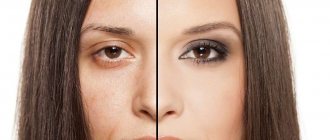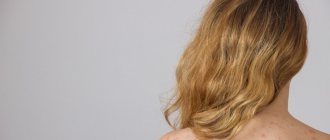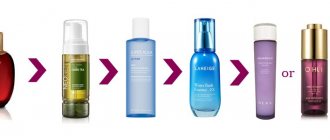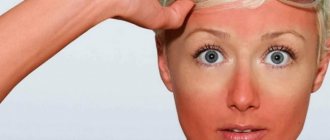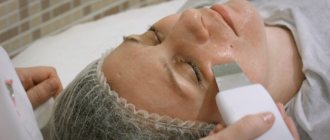The essence of basic cleansing procedures
For deep skin sanitation, cosmetologists offer 2 procedures: cleansing and peeling (exfoliation).
The first treatment option involves cleansing the pores from the contents: waste products, external contaminants (residues of cosmetics, dust). Manipulation is carried out by hand or using tools, devices, and special cosmetics. The skin, thanks to the effect, is freed from dirt and destructive elements. The covers look clean and healthy.
Peeling involves exfoliating the keratinized layer of cells from the surface of the epidermis. The procedure is carried out using mechanical action and the use of chemicals. The skin, thanks to manipulation, is freed from the dead layer. Covers look better and function more efficiently. The procedure allows you not only to cleanse, heal, but also rejuvenate the epidermis. After peeling, scars, wrinkles, and age spots are smoothed out on the surface, and the rate of age-related changes slows down.
Difference between cleansing and exfoliating the face
Peeling is a procedure aimed at facilitating the process of removal of keratinized scales from the surface of the face, which may affect one or more layers of the epidermis. As a result of this effect, you can get rid of a number of pathological conditions characteristic of certain types of epidermis, and significantly rejuvenate the tissue. Experts do not recommend peeling before the age of 25; this can significantly affect the body’s own strength, which should help it cope with problems.
Cleaning is a superficial procedure, which is often accompanied by specific manual manipulations. The purpose of the sessions is to rid the pores of contents (dirt, decorative cosmetics, excess fat, germs), remove acne cones and comedones, and cleanse their cavities for a speedy recovery. This is both the treatment of aesthetic defects and the prevention of tissue infection. With the right approach and safety precautions, sessions can be carried out at any age, starting from the stage of teenage problems.

Thus, facial cleansing and peeling are similar, but at the same time different procedures. They are often carried out one after another, this is especially effective in the therapeutic treatment of problematic epidermis.
Another principle by which sessions can be distinguished from each other is the method and technique of manipulation. Despite the fact that most peelings are called cleansing, only mechanical effects on the skin can really be classified as this group of procedures. Hardware and chemical cosmetology offers peelings, because their purpose is not only to cleanse the surface of the face, but also to rejuvenate tissues, restore their freshness, control biochemical processes, and improve the functioning of blood vessels.
Facial cleansing and peeling are procedures of varying depth of impact. While peeling can be carried out both on the surface and in the deep layers of the epidermis, cleansing is a purely superficial procedure. If cleaning is carried out incorrectly or overly aggressively, it can affect deep tissues, which can lead to damage to blood vessels, the occurrence of hematomas, the development of inflammatory processes, capillary bleeding, and infection in wounds.

Preparation for procedures
The basis of preparation for any skin cleansing procedure is maintaining the health of the epidermis. Interventions are not carried out if there is inflammation, irritation, or damage on the surface. It is recommended to postpone manipulation during periods of illness, poor health, taking antibiotics, hormones, or during menstruation. Unstable hormonal levels and reduced immunity will slow down the recovery process.
During the preparation period, it is recommended to give up alcohol and other bad habits. It is advisable to lead a healthy lifestyle: eat right, follow a sleep schedule, and drink enough fluids.
To facilitate the cleansing process, it is recommended to introduce into your regular care routine the use of products that have a loosening effect on the skin. This will soften the stratum corneum and the contents of the pores. The cosmetologist will tell you whether it is necessary to change the care system in any other way.
Important! Immediately before the cleansing procedure, it is recommended to steam the epidermis. This is performed in conjunction with basic sanitizing actions. Manipulation allows you to maximally prepare the tissue for the basic procedure.
Combination of cleansing effects
It is not recommended to combine standard cleaning and peeling into a single complex. Each impact injures tissue and requires time for effective recovery.
Simultaneous cleaning and peeling can lengthen and complicate rehabilitation. Cosmetologists sometimes combine different types of cleansing, focusing on the individual characteristics of the patient. The doctor assesses the current situation and makes a decision. It is not recommended to prescribe the steps of a cleansing program on your own.
Different types of effects (cleaning, peeling) complement each other perfectly if performed in a light version. Before cleaning, it is useful to carry out a superficial chemical peel using solutions of minimal concentrations. A similar effect can “close” cleaned pores.
Carrying out traumatic cleansing immediately before peeling is of dubious benefit. It is recommended to do without classical cleaning. In anticipation of exfoliation, it is better to use a steaming, deep cleansing mask that will open the pores and remove excess dirt.
You should be especially wary of traumatic effects before performing medium, deep peels. Cleaning is prohibited before carbon, salicylic or retinol exfoliation, which involves complex rehabilitation.
Cleansing pores before exfoliation
It is best to free pores from impurities before peeling using special products that soften and draw out impurities.
At home, these are masks based on black and other types of clay, activated carbon. Among professional products there are also many options with a similar composition.
You can also free pores from impurities by performing light ultrasonic cleaning. At home, devices intended for domestic use are used. Act strictly according to instructions.
How does facial cleansing work?
To begin with, the skin is completely cleansed of all impurities and absolutely all makeup is removed. Remove makeup and dirt using a special gel and antibacterial agents. Most often, anti-inflammatory drugs can be found in such gels. Therefore, from the moment of cleansing, deep care for your face begins.
After purification, hydrogenation is done. Hydrogenation is carried out using gel masks. With their help, the greenhouse effect occurs. This is necessary so that dead cells soften and are easily removed. Hydrogenation allows you to delicately soften the horn cells without burning the skin with hot steam. With the help of hydrogenation, pores are cleaned much easier, dead cells are easily removed. After the hydrogenation is done, the cosmetologist begins the cleaning itself. The skin is mechanically cleansed and acne is removed. The epidermis is effectively cleansed of impurities.
After mechanical cleaning, peelings are also used. With the help of peeling, the remaining keratinized cells are removed, pigment spots and post-acne are removed.
In order to soothe the skin after all these procedures, a mask is applied. With its help, the skin calms down and regeneration begins. After the mask, the results are secured with cream. The cream protects the delicate, cleansed dermis from external conditions.
Delay period: when can you cleanse your pores?
If professional cleaning and peeling is necessary, it is recommended to take a break between procedures. The grace period is often 7–10 days. After a week, the skin usually recovers. How much time is needed in a particular case is determined by address. The duration of the rupture depends on the individual characteristics of the patient: skin type, condition of the integument, age, ability to recover.
The treatment option performed first will be determined by the cosmetologist. The doctor focuses on existing needs. Most often, the first step is cleaning, which is preceded by a light acidic effect: preparing the skin at home or superficial peeling, as part of the basic procedure, which allows you to soften the stratum corneum and improve access to the pores.
In case of an excessively thickened stratum corneum, which cannot be removed with a light acid effect, it is advisable to change the order of procedures: first, professional superficial peeling is performed, then cleaning by a cosmetologist. If you intend to perform deep exfoliation, the sequence does not change.
Deep cleansing of the skin is a necessity for everyone. You can get effective results from professional procedures if you strictly adhere to the nuances of the procedure. The main details of the intervention are the correct choice of cleansing effects and their proper alternation.
How to treat acne and acne
This problem definitely needs to be treated.
If acne gets too bad, you can get a large number of scars that cannot be removed. First of all, you need to consult a cosmetologist. He will examine you, study the problem, and determine the severity of the problem. Treatment will depend on how advanced the acne is, what age the patient with acne and acne is, and what kind of skin the patient has. After consultation with a cosmetologist, he will determine how to treat this problem. When treating acne, cosmetologists use only certified and reliable cleaning and peeling devices.
All devices are approved by the World Health Organization and are approved for use in cosmetology clinics. Cosmetologists use the latest equipment that keeps pace with progress.
There are a lot of ways to get rid of acne and acne, but mainly it is facial cleansing and various peelings.
Ultrasonic peeling is used. This is the latest technology that helps remove dead skin cells from the skin, remove everything, even deep impurities, and cleanse the skin of fat and sebaceous plugs. This peeling also effectively gets rid of comedones and acne. Although ultrasonic peeling is very effective, it only affects the very top layer of skin. Working with this layer is enough to effectively cleanse the pores and make the skin as smooth, clean, and beautiful as possible. Ultrasonic peeling is used mainly for those whose pores are only superficially contaminated and whose acne is not severe. For people with severe acne, other treatments are available.
Ultrasonic peeling helps make blood circulation faster, due to this the skin is well moisturized without the use of special products. The density of the dermis increases greatly, the skin becomes much younger. Facial muscles become more toned, ultrasonic peeling gives the effect of a good facial massage. The skin becomes more saturated with oxygen, making it look much younger.
Often, various medications are also used in combination with ultrasonic peeling. This is called ultrasound therapy. With the help of this therapy, acne goes away, inflammation disappears, and the epidermis is greatly moisturized. The protective layer is restored.
Cleansing is also very effective in getting rid of acne and acne. Of course, you can do facial cleansing yourself, at home. However, this will only make it worse and harm your skin. You can greatly aggravate the situation, the acne will spread much more. If cleaning is carried out by professionals, then as a result you will get a healthy and as smooth as possible dermis.
Peeling and cleansing - what's the difference and which is better?
Among visitors to beauty salons, heated debates do not subside on the topic of which is better - peeling or cleaning (manual, ultrasonic, vacuum, etc.).
Or maybe you don’t need to be tormented by the problem of a difficult choice and let the cosmetologist do both procedures - cleansing and chemical exfoliation? Wouldn't this be an excessive burden for one individual?
But even in the issue of using these two procedures together, not everything is so simple and again the question is - what to do first - exfoliation or cleansing? At what interval are procedures carried out so as not to provoke the same excessive load on the skin? The good news for those who love perfectly clear and smooth facial skin is that exfoliation and cleansing work well together. Depending on the indications (usually determined by a cosmetologist), procedures can be performed in tandem with a relatively short interval. The cosmetologist also determines the order.
Peeling and cleansing - what's the difference?
To understand the differences between professional cleaning and chemical exfoliation, you should highlight the features of both procedures.
Table “Peeling and cleaning – what’s the difference”
| Exfoliation | Cleaning |
| It is carried out using various drugs and means. | Superficial cleansing of the skin using hands or special devices. |
| The goal is to cleanse the skin of keratinized scales formed in the layers of the epidermis. | The goal is to remove subcutaneous fat, dirt, blackheads, cosmetic residues, etc. |
| Promotes skin rejuvenation by improving and restoring blood vessels. | In the process, infection is prevented along with the elimination of cosmetic skin defects. |
| Recommended for clients over 25 years old. At an earlier age, it can affect the body’s protective reserves and its ability to cope with skin problems. | Suitable for any age, especially suitable for teenage skin. |
So, the key differences between the two procedures are the following factors:
- Depth of impact;
- Execution technique;
- Productivity.
Cleaning is not as deep
Manual mechanical cleaning is a hygienic procedure in which all manipulations are performed at the upper level of the skin layers. During the intervention, impurities, blackheads, excess sebum and other defects are removed.
The exfoliant is aimed at a deeper effect, which affects not only the epidermis, but also the dermis itself. During the procedure, special devices or acids of varying concentrations are used.
Cleaning can be done at any age
Another factor that comes into play in the question – what is the difference between peeling and cleansing the skin – is age. Unlike exfoliation, cleansing can be done at almost any age. If there are indications, peeling is allowed to be performed by persons over 14 years of age, ideally from 25. Deep exfoliation is not prescribed at all before 40-50 years of age, because this procedure affects the deepest layers of the skin.
There is no chemical, only mechanical
Cleaning is performed by a cosmetologist using his fingers or using special devices, i.e., mainly mechanically, without any multi-acid compositions.
Both manipulations involve exfoliation of the upper layer of the epidermis. But the process of peeling is chemical, acidic, which is fundamentally different from cleansing.
Cleansing is performed using fingers or special devices. In other words, in this case there is only a mechanical effect without the use of chemical components.
Cleaning only removes dirt and rashes
In the process of choosing from two main cosmetic procedures, the client will invariably be faced with a choice: peeling or cleansing, which is better?
Cleaning is designed to solve only a limited number of skin problems (i.e., help eliminate sebaceous plugs, comedones, blackheads, etc.).
Peeling is suitable for those with age spots, dull skin, and age-related facial changes. As a rule, exfoliation eliminates a much larger number of skin imperfections, and in some cases it can even replace a facelift.
Cleaning is done once a month, peeling – once a week
According to most cosmetologists, cleansing is a necessary procedure in the facial care process. Unfortunately, it’s not possible to cleanse your face “once and for several years.” For this reason, facial cleansing is recommended on average once a month.
According to the qualified opinion of specialists, peeling should be done in a course, approximately once every 7 days.
By the way. Often clients of cosmetology clinics are interested in the question: is it necessary to clean before peeling? The answer largely depends on the client's skin condition. In some cases, such procedures complement each other perfectly.
Recommendations from a cosmetologist:
- On the day after cleaning, do not wash your face with water, because... the effect of the applied masks will still continue. Do not apply cream or decorative cosmetics.
- To cleanse the skin, use an antibacterial lotion or toner (without alcohol!).
- Until the inflammation goes away after cleansing, do not perform any manipulations with the skin, do not tint eyebrows/eyelashes, etc.
- If crusts form after a few days, do not tear them off by force, because... Scars and pigmentation may remain.
- After cleaning, do not visit the bathhouse, sauna, solarium, sunbathe or swim for 2–6 days, because bright sunlight can contribute to the appearance of pigmentation, and water in reservoirs can be a source of bacteria.
- Before going outside, protect your face from the sun, apply sunscreen with a high level of protection (SPF at least 15, the higher this figure, the better).
- Do not use any foundation or powder during the entire recovery period, as... they can clog newly cleaned pores.
- Repeated facial cleansing is recommended after 2-3 months for normal skin, and after 1 month for oily skin.
- Do not wash your face with hot water. This advice applies to any period of time, but is especially relevant after cleansing your face. Hot water stimulates sebum production, which can cause clogged pores.
- Do not drink alcohol, even weak alcohol. Alcohol stimulates blood circulation and increases water retention in tissues, which will worsen swelling.
- You can’t use a scrub for a week, even the softest one. The skin is already traumatized after cleansing your face; there is no need to subject it to even more stress.
- Do not touch your face unless absolutely necessary. This can cause irritation of the thin, sensitive epidermis, causing infection in wounds and cracks. Do not let children touch their faces. Be careful with male stubble.
- Do not wash with running tap water. It contains a lot of bleach and chemical impurities used for cleaning and disinfection. For sensitive skin, I recommend washing your face with boiled water on the first day after cleansing.
- Never use soap to wash your face. It dries out epidermal tissues due to the high content of alkaline compounds.
- Change the pillowcase.
In the cosmetology office “Laboratory of Rejuvenation” they quickly and painlessly do all types of facial cleansing - mechanical, ultrasonic, combined. Israeli professional cosmetics are used in the work.
Types of facial peels
Ultrasonic cleaning and chemical peeling using acids of different concentrations are the procedures most often found in the price list of beauty salon services. Before deciding on one or another manipulation (or maybe both at once), you should find out what types of peeling exist.
Superficial
These types of peeling are based on fruit acids (so-called AHA acids): lactic, glycolic, malic, mandelic or tartaric. Their concentration is usually low, which makes this procedure gentle and soft. This exfoliation acts exclusively on the surface layer of the epidermis, which does not have living cells. As a result, sebum dissolves and the thickness of the epidermis decreases. Thus, high-quality restoration of the skin occurs, smoothing of surface wrinkles and elimination of pigmentation. Superficial exfoliation is suitable for clients with young (over 25 years old) skin. It is permissible to carry out such peeling in a course of 7-10 procedures, taking a break of 10 days each time.
Median
Median exfoliation products are able to penetrate to the level of living cells and trigger their exfoliation processes. This peeling gives strong results - renewal of skin cells, as a result - enhances its regeneration, triggers the processes of natural production of collagen and elastin. The course of such peeling is from 1 to 3 procedures with an interval of 1 month.
Deep
Deep cleansing (phenol peeling) aims to completely remove “old” layers of skin. The composition does not affect only the thin cellular layer, the so-called areas of cell growth. This is where the growth of a new layer of epidermis occurs. Is cleaning necessary at all, in particular deep cleaning with phenol peeling? Undoubtedly, if the following signs occur:
- pronounced processes of integument withering;
- deep wrinkles, creases;
- age-related pigmentation;
- presence of scars.
Peeling after
Peeling after cleansing your face is the best option. Typically, peelings are carried out in courses, after a 7-10-day rest after cleaning. By this time, the epidermis is completely restored, and the skin is ready for the next procedures.
It is after all the dirt has been removed from the pores that it becomes possible to more effectively influence the deep layers of the epidermis: even out the tone, eliminate the first signs of fading and consolidate the result.
Sometimes it is impossible to achieve the desired effect in one procedure. For example, a cosmetologist may suggest two or three professional cleanings with an interval of 7-10 days if the pores are very clogged and there is inflammation. In this case, you first need to disinfect the pores: remove impurities, cure inflammation and wait for the injured areas to heal. And only after such treatment will it be possible to proceed to a course of peelings.
FAQ
Potential clients of cosmetology clinics often have a number of questions. The most typical of them include:
- How to choose the right procedure based on the client’s age and skin type?
- Is it possible to clean and exfoliate at the same time?
- Is it possible to exfoliate after cleansing?
- Which procedure should I choose in terms of economy?
What to prefer depending on skin type
Age characteristics of the skin and its type are the main criteria that should be followed when choosing a facial cleansing procedure.
Table “Skin type and cosmetic procedures”
| Skin type | Professional facial cleansing | Peeling |
| Normal | Ultrasonic | Containing fruit acids, scrubbing is acceptable. |
| Dry | Ultrasound, Laser biorevitalization | Cream peeling, roller peeling, ultrasonic peeling or laser resurfacing are acceptable. |
| Fat | Manual procedure using a spoon or Uno loop | Containing hyaluronic acid, let's say Brossage or microdermabrasion. |
| Problematic | Vacuum or deep ultrasonic | Jessner peel, saline or retinoic. |
Is it possible to do peeling and cleansing at the same time?
Is it possible to do peeling and cleansing at the same time?
As a rule, it is not forbidden to do two of these procedures at the same time - they enhance the effect of each other and complement each other perfectly. But only a cosmetologist should decide on the advisability of such an integrated approach. Ideally, there should still be a certain interval between such interventions so as not to injure the skin needlessly.
Is it possible to exfoliate after cleansing?
Is it possible to do peeling after cleansing the skin of the face?
Yes, because these two procedures are considered complementary.
Thus, cleansing after peeling helps to more effectively, easily and quickly remove impurities from the pores.
Exfoliation after cleansing will allow you to maintain the achieved result for a long time, at the same time evening out your complexion and eliminating the first signs of skin aging.
Care after facial cleansing
Tips for caring for your face after cleansing at home or with a cosmetologist:
- Throughout the entire recovery period, you should treat your face with delicate nourishing products. Mixtures containing alcohol can be applied locally to inflamed areas.
- To relieve inflammation, the skin should be rinsed with decoctions of chamomile, plantain, calendula or St. John's wort. Herbal compresses will also help relieve irritation and swelling in a short time.
- 1-3 days after exfoliation, wash with melt or mineral water - this will help reduce the risk of spreading the infection. Adding two drops of lemon juice or apple cider vinegar to high-quality water will help even out your complexion and activate regeneration processes at the cellular level.
- For a speedy recovery, you need to apply a cream selected daily, taking into account the type of dermis, to your face, which has a nourishing and moisturizing effect. Before going outside, you should use a product with a high level of protection against ultraviolet rays - this will prevent the appearance of peeling and age spots.
2-3 days after cleansing, mesotherapy or biorevitalization is allowed, provided that there is no inflammation on the cleansed skin. Additional treatments to eliminate greasy shine and various rashes can be done no earlier than a week after exfoliation.
After salon cleansing, the cosmetologist treats the epidermis with a soothing mask, which helps to quickly get rid of redness after cleansing the facial skin, and selects an individual course of care for the recovery period, depending on the type of cleansing.
After mechanical cleaning
Manual exfoliation is the most traumatic technique; after it, in addition to the general rules for caring for the epidermis, it is recommended to adhere to specific recommendations:
- treat the dermis with mild agents with an antiseptic effect;
- remove excess subcutaneous fat with natural tonics without alcohol;
- When new rashes appear, apply Metrogyl gel to them 2 times a day.
After vacuum cleaning
After cleansing with a vacuum, you should treat your face daily with products with a moisturizing, soothing and nourishing effect - this will help get rid of puffiness and red spots. If bruises appear after the procedure, a cosmetologist should choose a method for eliminating them.
After ultrasonic cleaning
After ultrasonic exfoliation, you need to make masks with cosmetic clay selected for the type of dermis and seaweed once every 3 days throughout the entire rehabilitation period - this will help moisturize the skin and saturate it with useful microelements. It is necessary to use sunscreen for 3-4 weeks.
After laser cleaning
After laser peeling, you should not wash your face for 4–6 days; during this period, only alcohol-free toners can be used to remove impurities. It is necessary to avoid scrubbing agents for a month so as not to damage the healthy layers of the epidermis.
At home, a few days after cleansing, it is recommended to use the following natural healing masks:
- Bodyaga - helps get rid of bruises and minor hematomas. The product is applied to problem areas and removed with warm water after 5–15 minutes. Not recommended for use by those with dry skin.
- Egg-lemon. Mix egg white and a few drops of lemon juice and apply to skin - helps even out skin tone and tighten pores.
- Cucumber. Rinse your face with warm water and apply the vegetable slices to your face, leave for 30–50 minutes. The mask helps saturate the dermis with essential microelements, eliminates swelling and redness.
- Sour cream. Rub sour cream into the skin along massage lines, rinse after 30–40 minutes. The product helps.
Masks are allowed to be used no more than 2 times a week. Before the first application, you should do an allergy test - for this, a small amount of the prepared mixture is distributed on the bend of the elbow and left for 15-25 minutes. If during this period of time there is no strong burning sensation, feeling of tightness, itching and severe redness, you can use the mixture for its intended purpose.


